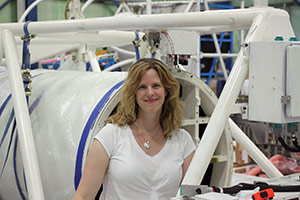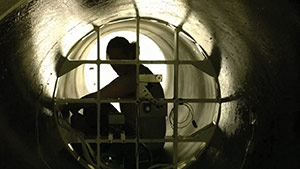connect
Learned Fearlessness
Breaking Into Space Science
 PHOTO: COURTESY OF NASA
PHOTO: COURTESY OF NASAJessica Gaskin co-led the development of this 5,000-pound telescope that's part of the proposed SuperHERO program. The telescope flew on a scientific balloon that's longer than a football field and travels to an altitude of around 130,000 feet.
NASA scientist Jessica A. Gaskin, PhD (GRS '98, astronomy), doesn't worry much about breaking things. When a graduate student she supervised accidentally broke off a screw inside a $600,000 scanning electron microscope, he thought it was the end of his career. Instead, it was a rite of passage, and Gaskin framed the screw for him.
Gaskin's response to that mistake isn't simply a philosophy for training scientists; it's a guiding principle for doing science, one she learned while earning her master's degree at Case Western Reserve. R. Earle Luck, PhD, the Worcester R. and Cornelia B. Warner Professor of Astronomy, told her that once she broke something valuable—an inevitability in space science—she'd understand that the world did not end. Through her career, that advice has made her less afraid to try new things.
Since then, Gaskin has accidentally destroyed electron filaments, fried telescope components and imploded a vacuum chamber—"Not my fault, by the way"—with a fearlessness that, combined with an abundance of smarts, achievements and hard work, led her to win a NASA Early Career Achievement Medal last year.
And it's given her a leading role on NASA's X-ray Surveyor telescope project. It's the proposed successor to the Chandra X-ray Observatory, which launched into space in 1999, is the world's most powerful X-ray telescope and orbits 200 times higher than the Hubble Space Telescope. Still at the concept stage, X-ray Surveyor would have an even more powerful telescope than Chandra and would be able to see objects even fainter and farther away.
A study scientist based at NASA's Marshall Space Flight Center in Huntsville, Ala., Gaskin doesn't focus on a single research question. Instead, she works to help a community of researchers around the country define a long list of scientific questions, including: How do black holes form? How do they co-evolve with galaxies? How do galaxies emerge? The desire to answer these questions defines how the X-ray Surveyor telescope will be configured.
Gaskin breathed in astronomy from childhood, and not only because she grew up near the Johnson Space Center in Houston. "It just came naturally," she said. "At home, we looked at the stars every night, every vacation." But it was during her time at Case Western Reserve that Gaskin realized how she wanted to focus her career.
"Probably my best time was at the university," she said. "It was definitely a turning point for me." Working with Luck at the McDonald Observatory in Fort Davis, Texas, taught her something important about herself. "We had to handle an extremely large telescope and a very large dome to make observations. I realized later that what I really enjoyed most about that was not the analysis after, but understanding the intricacies of the telescope and the instruments."
Further, the small class size at Case Western Reserve—Gaskin was one of only two graduate students in astronomy then—meant she tried a little of everything. "That really helped me understand that focusing on one particular area wasn't something I was interested in. I'm more interested in being a jack-of-all-trades and doing lots of different things, and not being afraid to try new things," she said.
As for breaking things, she finds Earle Luck's words provide a take-home lesson for guiding her three sons, Jacob, 8, William, 7, and Peter, 4. "They break things all the time, whether I like it or not. It's part of the learning process. You have to make mistakes. You have to break things. That's how we learn."
Jessica Gaskin
 PHOTO: COURTESY OF NASA
PHOTO: COURTESY OF NASA Gaskin working inside the HEROES telescope to install specialized monitoring equipment.
BS: New Mexico Institute of Mining and Technology
MS: Case Western Reserve University
PhD: University of Alabama at Huntsville
- Study scientist for the proposed X-ray Surveyor telescope project.
- NASA's Marshall Space Flight Center principal investigator for the HEROES (High Energy Replicated Optics to Explore the Sun) project, which in 2013 launched an enormous balloon toting an X-ray telescope capable of capturing images from the sun and stars. Although that mission ended, Gaskin and her teammates are proposing a follow-up undertaking with more powerful instruments, this one called SuperHERO.
- Designer of a palm-sized scanning electron microscope for a future Mars rover.





